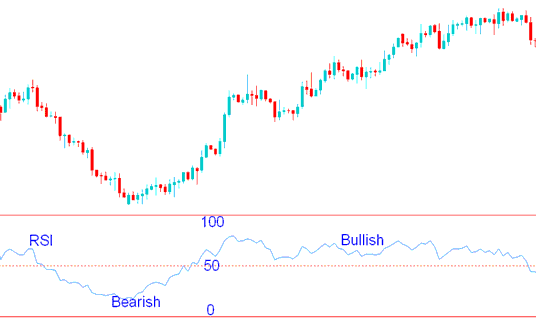RSI Strategy
Relative Strength Index or RSI is one of the most popular Indices indicator used in Index trading. It's an oscillator indicator which oscillates between 0 -100. This a trend following indicator. It reflects the momentum of the market trend, values/readings above 50 show a bullish trend while values below 50 show bearish trend.
RSI Measures Momentum of a Index Trend.
The middle line for the RSI is the 50 indicator: when it crosses this line, it means the trend is going from positive to negative or the other way around.
When RSI stays above 50, buyers have more momentum than sellers. As long as that's the case, the price on the chart keeps climbing.
Below 50, sellers outpace buyers on the RSI. Prices drop while the indicator stays under 50.

RSI - How to Trade with RSI Indicator
In the example above, when the RSI stayed below 50, prices kept dropping in the index market. As long as the RSI stayed under 50, the downtrend continued. But once RSI moved above 50, it signaled a shift from selling to buying, and that downtrend wrapped up.
Once the RSI indicator ascended above the 50 level, the price began its upward trajectory, signifying a shift in the trend from bearish dominance to bullish. The chart price subsequently maintained its climb, with the RSI indicator staying above 50 thereafter.
In the example above, when prices were rising, the RSI would sometimes go down but stay above 50, showing these drops are just pullbacks since the price was generally going up. The upward trend stays strong as long as the RSI indicator stays above 50. That's why the 50 center-line is used to tell apart rising and falling signals.
RSI defaults to a 14-day period. J. Welles Wilder set that standard. Traders often pick 9 or 25 days instead.
The RSI period fits your chart's time frame. On a daily chart for day trading, 14 means 14 days. On a one-hour chart, it covers 14 hours. We'll use 14 days here. Adjust it to match your Stock Index trading frame.
To Calculate RSI Indicator:
- The No. of days that a Index market is up is compared & analyzed to the number of days that the market is down in a given period of time.
- The numerator in the basic formula is an average of all the trading sessions that finished with an upward price change.
- The denominator is an average of all the down Index sessions closes for that period.
- The average for the downward days is calculated as absolute numbers.
- The Initial RSI is then turned into an oscillator.
Occasionally, significant price movements - either sharply upward or downward within a single session period - can distort the Relative Strength Index (RSI) calculation, potentially giving off a false signal in the form of a spike.
The RSI centerline sits at 50 for this index tool. Above 50 means a bullish trend, with gains outpacing losses. Below 50 signals bearish action, as closes fall under opens.
Overbought & Oversold Levels: Wilder decided that the RSI overbought and oversold levels, where market moves are too far, are at 70 and 30.
Get More Topics and Courses:
- Best Strategies Methods for Indices Trade Course Tutorial
- How Can You Find GER30 on MT4 App?
- How Can You Trade UsTec100 on MetaTrader 5 Software Platform?
- T3 Moving Average Stock Index Indicator Analysis
- Coppock Curve Stock Index Technical Indicator Analysis
- How to Set DAX30 on MT4 App
- Moving Average MA Indices Trading Strategies Example
- How Do You Set AEX in MT4 App?
- How Much Money is 1 Index Nano lot/contract in Index Trade?
- MACD Oscillator Indices Analysis Fast Line and Signal-line

